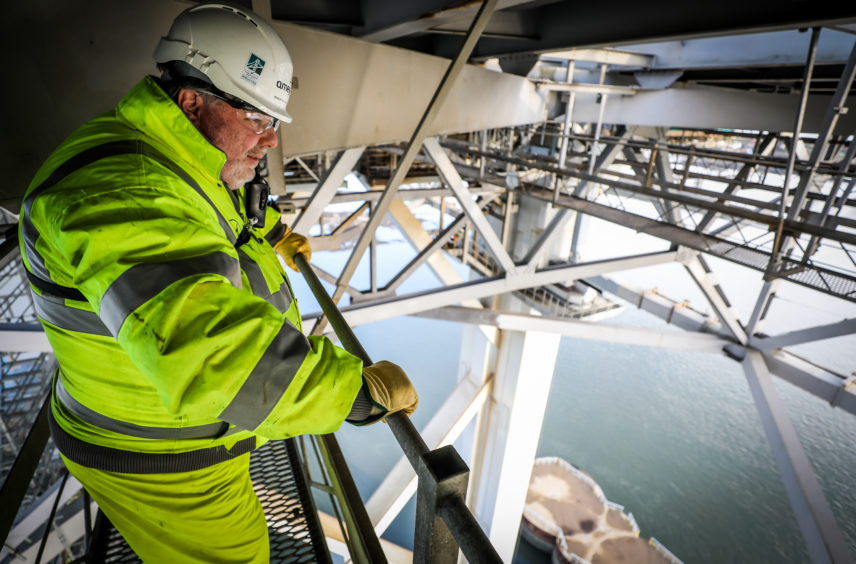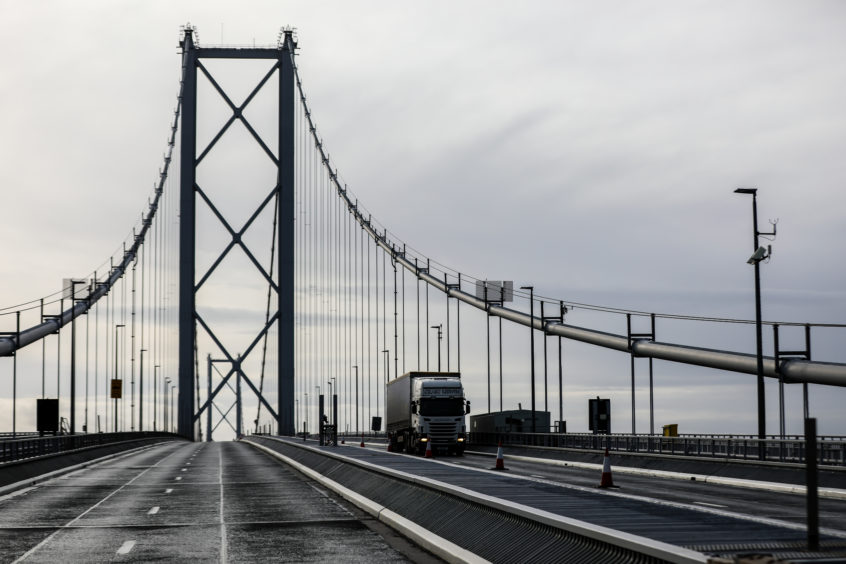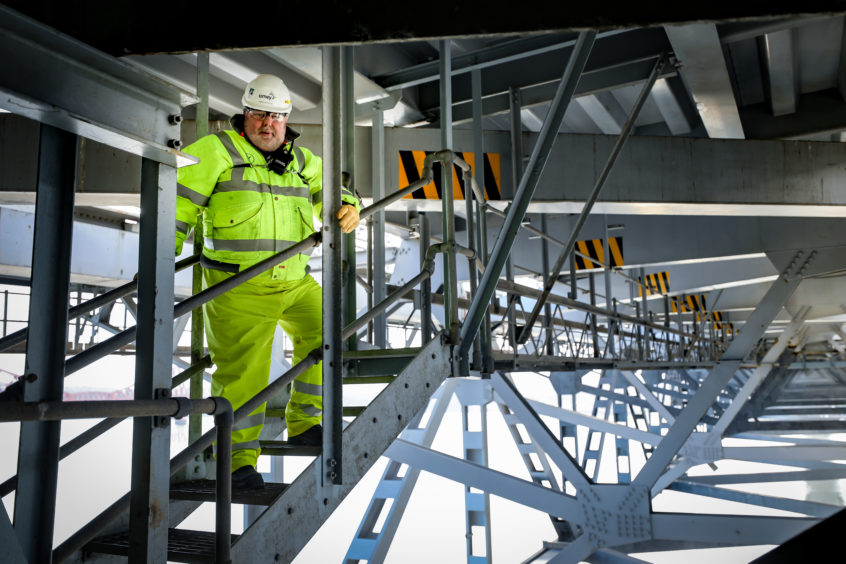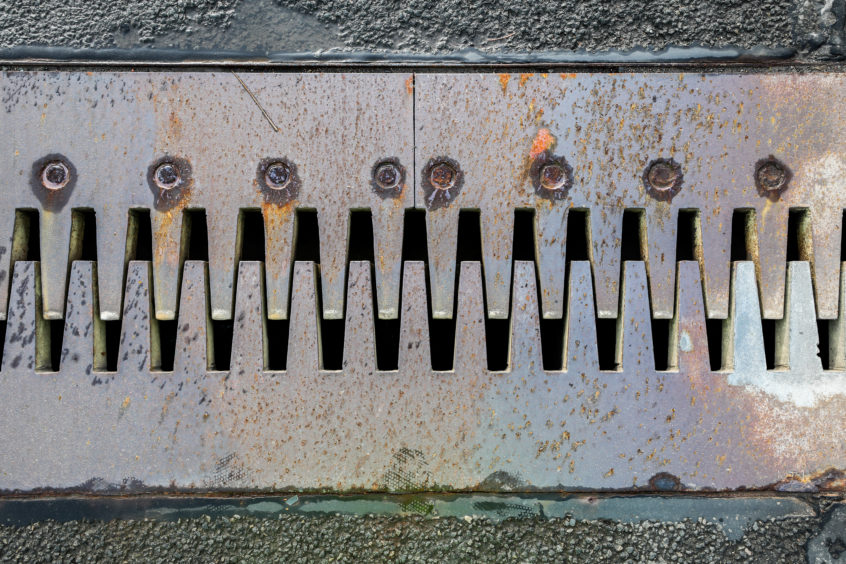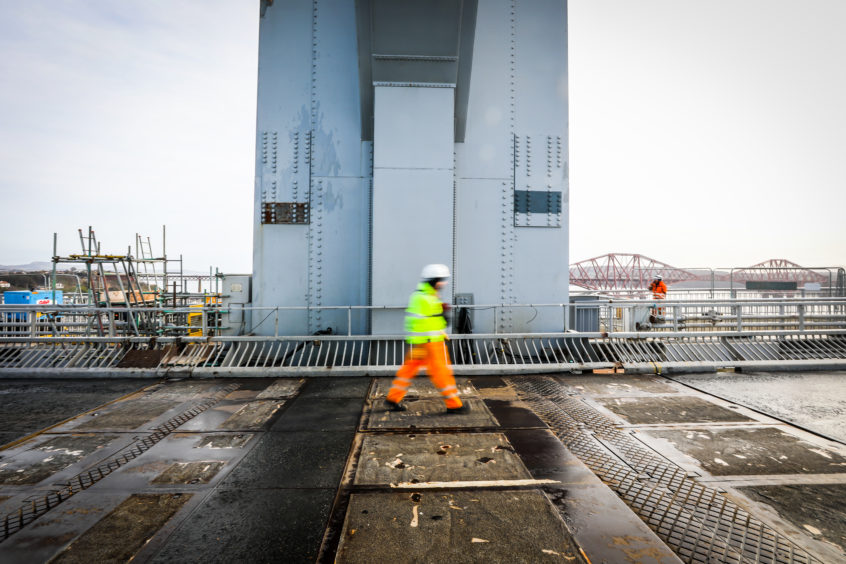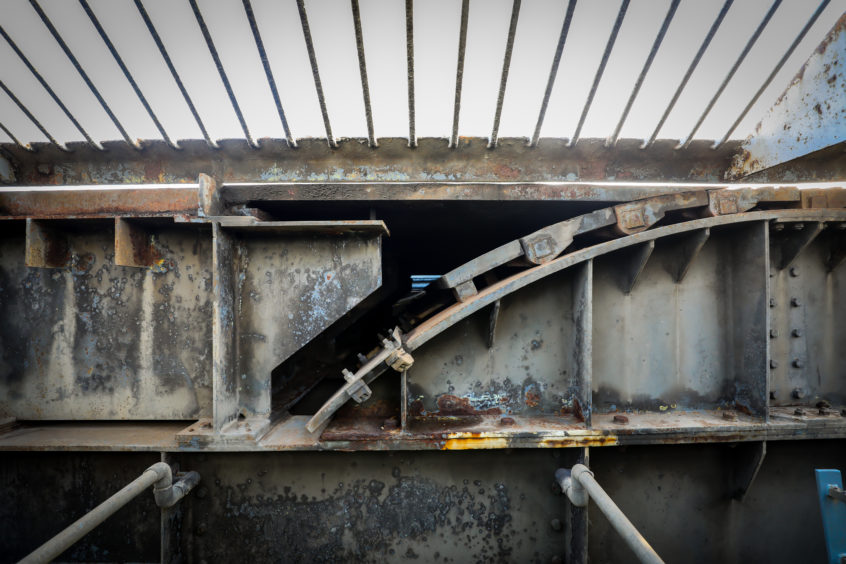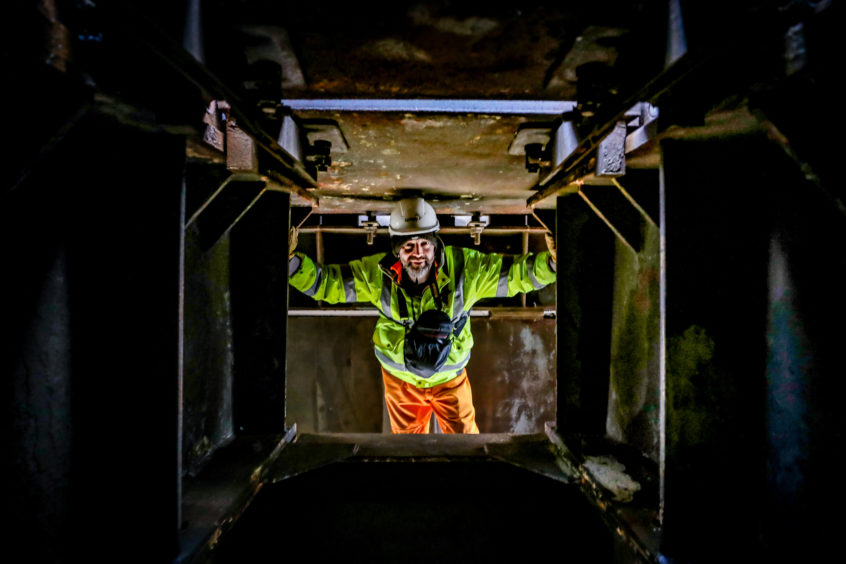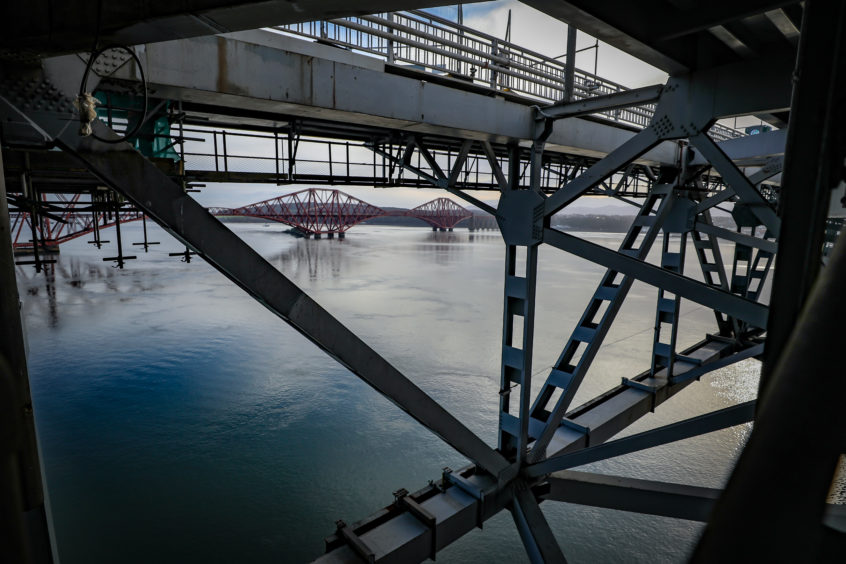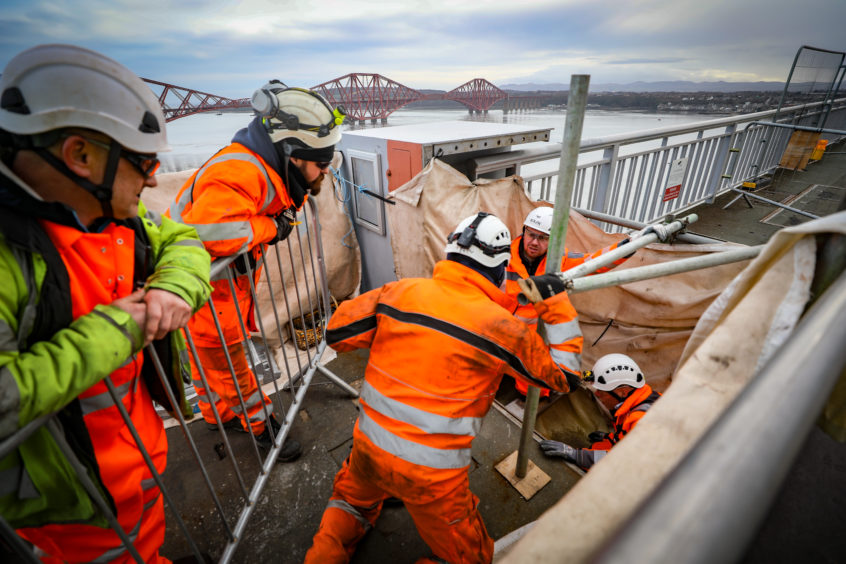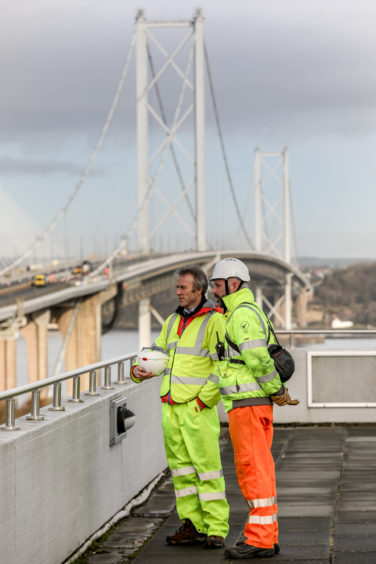Michael Alexander went ‘behind the scenes’ with engineers working on a £7 million Forth Road Bridge repair project
Every job has its ups and downs.
But during the 12.5 years that Dunfermline-raised senior civil engineer Robert McCulloch has been helping to maintain and operate the Forth Road Bridge, those lateral movements have often been quite literal.
Incidents witnessed from the bridge control room at South Queensferry over the years have ranged from a boat cowping from a trailer onto the deck, poorly-strapped portable toilets and polystyrene blocks blowing from lorries into the river and emergency action being required after a passing cement mixer driver somehow accidentally sprayed his cement load onto the road.
“When you had 70-80,000 vehicles per day crossing the bridge, statistically things were going to happen,” said the engineer, adding that for most of the bridge’s 55-year history, it has operated smoothly.
But ever since the Forth Road Bridge became a dedicated public transport corridor in January last year following the opening of the new £1.3 billion Queensferry Crossing as a motorway, it shouldn’t come as a surprise that the number of disruptive incidents on the old crossing have reduced dramatically.
With use of the old bridge now limited to buses, taxis, small motorcycles up to 125cc, agricultural vehicles, cyclists and pedestrians, there are now just 800 vehicles per day using it of which around 500 are buses.
Stagecoach recently reported that the number of passengers travelling between Fife and Edinburgh via the bus corridor is up 10%.
However, another crucial advantage of mainstream traffic transferring to the Queensferry Crossing is that it is allowing bridge engineers to carry out major urgent repairs to the ageing Forth Road Bridge structure with absolutely minimal impact on the traffic now using it.
While there have been many headlines over the years about the ongoing work to ‘dehumidify’ the bridge’s weakened suspension cables – and a concentration of minds in 2015 when a Truss End Link failure led to an unprecedented three-week closure of the bridge for emergency repairs to fractured steelwork – it is a major 12-month project to replace all of the Forth Road Bridge’s main expansion joints which is currently the focus of attention.
Work on the crucial joints, which allow the bridge to expand and contract in the face of temperature fluctuations, high winds and heavy traffic, began on the east footpath in November, with work on the much larger joints in the main carriageways expected to begin in mid-March.
Traffic on the bridge – now managed and operated by Amey on behalf of Transport Scotland – is being restricted to a single lane in each direction for most of 2019 while work on the carriageways is in progress. Joints in the west footpath will be replaced once work on the carriageways is complete.
Guiding The Courier on an exclusive ‘behind the scenes’ tour of the works being carried out by Pennsylvania-based contractor American Bridge International, Amey engineer Mr McCulloch, 52, who is responsible for delivering the project, explained that the Forth Road Bridge’s main expansion joints were originally scheduled to be replaced in 2009, in what would have been by far the most disruptive maintenance project in the bridge’s history.
Plans were drawn up at that time to maximise traffic flow by building temporary overbridges across the joints.
However, HGVs – far heavier than those taking to the roads when the bridge was designed – would have had to divert to Kincardine for the duration of the works at great cost to the economy, and traffic on the bridge would have been reduced to a single lane in each direction while the expensive overbridges were constructed and dismantled.
Traffic modelling predicted that “unbelievable” delays of up to seven hours in both directions could have become the norm.
“People just wouldn’t have got to work,” said Mr McCulloch. “People would have been on their way to work and it would have been time to come back again!”
Fortuitously, however, in December 2008 the Forth Estuary Transport Authority – which then managed the bridge – took the opportunity to postpone the works when the Scottish Government confirmed its timetable for construction of the Queensferry Crossing – a replacement deemed necessary due to the Forth Road Bridge’s corroding cables.
Amid concerns that crumbling expansion joints could lead to a hole opening up in the Forth Road Bridge carriageway, failsafe devices were installed for safety, along with improved maintenance access to allow an enhanced regime of monitoring and inspection to be implemented until the joints could eventually be replaced.
The current works will now cost just under £7 million – around half the £13.7 million cost when they were originally tendered in 2008.
This saving is largely attributable to the Queensferry Crossing being available to carry traffic, meaning expensive overbridging works are no longer required.
Stepping onto the closed, traffic-free north-bound carriageway next to the North Tower before negotiating a series of gangways suspended from the underside of the bridge, Mr McCulloch pointed out how natural wear and tear had taken its toll on the steel joints with a virtual doubling of traffic from 12 million to 25 million vehicles per annum from 1964 to 2017 making the situation worse.
“These are the original joints installed in 1964,” he said.
“They’ve had routine maintenance. Normally joints of these type you’d replace every 30 years. But due to the logistics of actually trying to replace them on an operational bridge – especially one that had such a large traffic flow as the Forth Road Bridge did at that time – it’s very difficult to do.
“Following the decision in 2008, we’ve had to keep them going, and now thanks to the Queensferry Crossing being open we can close one carriageway for a long period of time without having any effect on the residual traffic.”
Mr McCulloch said all bridges expand and contract and, since the days of pioneering bridge builder Thomas Telford, they have been designed to accommodate this movement through expansion joints.
“This bridge is basically your Indiana Jones Rope Bridge across the gorge built out of different materials,” he said.
“It hangs there and it swings back and forward.
“That’s what a suspension bridge does. It’s a machine. And its constantly moving. “Anything that’s moving, things wear out and have to be maintained.”
The Forth Road Bridge main span was designed to accommodate a “massive” longitudinal movement of 1.8 metres, while the theoretical vertical movement of the bridge’s centre-point from the highest temperature in summer to the lowest temperature in winter is four metres due to variations in the sag of the cables.
If that doesn’t leave you feeling giddy, the theoretical sideways movement of the mid-span point during wind speeds of 110mph is a staggering 7.3metres!
“We used to close the bridge to all traffic when wind speeds reached 80mph, because you could actually feel seasick standing out there,” he added.
“You can see the whole thing going up and down and sideways all at the one time. It is very disconcerting. But those joints allow for all of that movement to happen.
“Without them, bridges like this would simply crack and collapse.”
The Forth Road Bridge has lost strength in its cables and there’s an inevitability that as the structure ages, it needs more work.
But with ongoing investment and today’s improved construction and design standards, Mr McCulloch sees no reason why it should not fulfil its theoretical 120-year lifespan. Just look at the Forth Bridge which celebrates its 130th anniversary next year!
“I would say these joints will last 50-years-plus,” he said, adding that the new joints have been manufactured in Ayrshire and Sheffield, using a similar overall design to the originals, but with improved materials and enhanced details.
“They are more maintainable, they are more robust, plus they are not going to take as big a load as they are doing just now.
“The bridge will always move. No matter how much traffic we take off it, due to wind and temperature the bridge will continue to move so these joints have to continue being there.
“But they won’t get the pounding from the traffic and heavy goods vehicles that the original ones have.”
